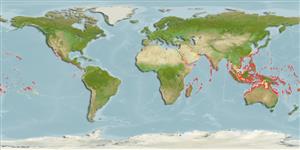Preferred temperature (Ref.
115969): 24.9 - 29.3, mean 28.3 (based on 3457 cells).
Phylogenetic diversity index (Ref.
82804): PD
50 = 0.5000 [Uniqueness, from 0.5 = low to 2.0 = high].
Bayesian length-weight: a=0.01288 (0.00846 - 0.01961), b=3.10 (2.98 - 3.22), in cm Total Length, based on LWR estimates for this species & Genus-body shape (Ref.
93245).
营养阶层 (Ref.
69278): 2.0 ±0.00 se; based on food items.
回复力 (Ref.
120179): 中等的, 族群倍增时间最少 1.4 - 4.4年 (tmax=20; K >0.30).
Fishing Vulnerability (Ref.
59153): Low to moderate vulnerability (30 of 100).
